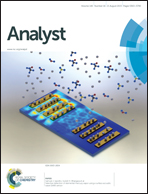A glucose biosensor based on glucose oxidase immobilized on three-dimensional porous carbon electrodes†
Abstract
A novel glucose biosensor was developed by immobilizing glucose oxidase (GOD) on a three-dimensional (3D) porous kenaf stem-derived carbon (3D-KSC) which was firstly proposed as a novel supporting material to load biomolecules for electrochemical biosensing. Here, an integrated 3D-KSC electrode was prepared by using a whole piece of 3D-KSC to load the GOD molecules for glucose biosensing. The morphologies of integrated 3D-KSC and 3D-KSC/GOD electrodes were characterized by scanning electron microscopy (SEM) and transmission electron microscopy (TEM). The SEM results revealed a 3D honeycomb macroporous structure of the integrated 3D-KSC electrode. The TEM results showed some microporosities and defects in the 3D-KSC electrode. The electrochemical behaviors and electrocatalytic performance of the integrated 3D-KSC/GOD electrode were evaluated by cyclic voltammetry and electrochemical impedance spectroscopy. The effects of pH and scan rates on the electrochemical response of the biosensor have been studied in detail. The glucose biosensor showed a wide linear range from 0.1 mM to 14.0 mM with a high sensitivity of 1.73 μA mM−1 and a low detection limit of 50.75 μM. Furthermore, the glucose biosensor exhibited high selectivity, good repeatability and reproducibility, and good stability.


 Please wait while we load your content...
Please wait while we load your content...